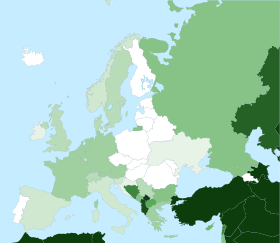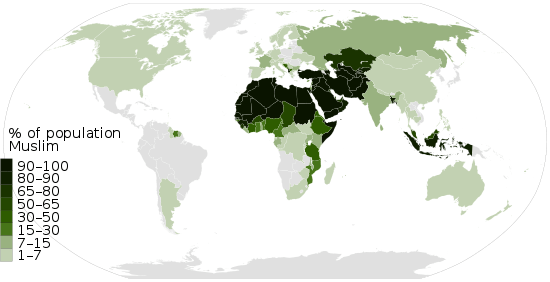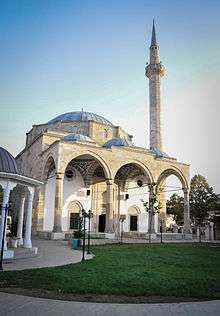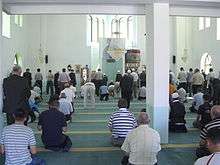Islam in Kosovo
Islam in Kosovo has a long-standing tradition dating back to the Ottoman conquest of the Balkans, including Kosovo. Before the Battle of Kosovo in 1389, the entire Balkan region had been Christianized by both the Western and Eastern Roman Empire. From 1389 until 1912, Kosovo was officially governed by the Muslim Ottoman Empire and, as such, a high level of Islamization occurred among Catholic and Orthodox Albanians, mainly due to high taxes, discrimination and socio-political opportunism. Despite these events, both Christian and Muslim Albanians intermarried and some lived as "Laramans", also known as Crypto-Christians.[2] During the time period after World War II, Kosovo was ruled by secular socialist authorities in the Socialist Federal Republic of Yugoslavia (SFRY). During that period, Kosovars became increasingly secularized. After the end of Communist period religion had a revival in Kosovo.[3] Today, 90-92% of Kosovo's population are secular Muslims, most of whom are ethnic Albanians.[4] There are also Slavic speaking Muslims, who define themselves as Bosniaks and Gorani, and Turks.

| 90–100% | |
| 70–80% | Kazakhstan |
| 50–70% | |
| 30–50% | North Macedonia |
| 10–20% | |
| 5–10% | |
| 4–5% | |
| 2–4% | |
| 1–2% | |
| < 1% |
| Part of a series on |
| Kosovo Albanians |
|---|
| Kosovo culture |
|
Art · Cinema · Dress · Literature · Music Sport · Cuisine · Mythology |
| By region or country |
|
Kosovo · Australia · Bulgaria Croatia · Germany Greece · Italy Kosovo · Macedonia Montenegro · Romania Serbia · Sweden Switzerland · Ukraine · United States |
| Varieties of Albanian in Kosovo |
| Gheg · Tosk · Arbëresh |
| Religion |
| Islam · Christianity · Roman Catholicism · Protestantism |
| History |
| Origins · History |
| Part of a series on |
| Albanians |
|---|
 |
| By country |
|
Native Albania · Kosovo Croatia · Greece · Italy · Montenegro · North Macedonia · Serbia Diaspora Australia · Bulgaria · Denmark · Egypt · Finland · Germany · Norway · Romania · South America · Spain · Sweden · Switzerland · Turkey · Ukraine · United Kingdom · United States |
| Culture |
| Architecture · Art · Cuisine · Dance · Dress · Literature · Music · Mythology · Politics · Religion · Symbols · Traditions · Fis |
| Religion |
| Christianity (Catholicism · Orthodoxy · Protestantism) · Islam (Sunnism · Bektashism) · Judaism |
| Languages and dialects |
|
Albanian Gheg (Arbanasi · Upper Reka dialect · Istrian) · Tosk (Arbëresh · Arvanitika · Calabria Arbëresh · Cham · Lab) |
| History of Albania |
History
Until the sixteenth century the degree of Islamisation in Kosovo was minimal, and largely confined to urban centres. The pace of conversions to Islam only increased significantly in the second half of the sixteenth century, possibly because high taxes, Ottoman retaliations and forced conversions.[5][6] Prior to the Ottomans, both Catholic and Orthodox Churches had waged a ruthless war over the hearts, minds and souls of the Albanians, and this situation was exploited by the Ottomans.[7] Both the Serbian Orthodox Church and the Sultan viewed the conversion of Albanians to Islam as something positive as it weakened Balkan Catholic nucleus, and the Sultan received new subjects.[8]
Converts also became exempt from the cizje, a protective tax levied only on non-Muslim males. But that was certainly not the only cause of the people turning and believing in Islam.[9] the tax burden tended to go up as Ottoman power relative to foreign Christian powers came under challenge. So far as Catholic Albanians were concerned, the Catholic church was less powerful and privileged within the Ottoman Empire than the Serbian Orthodox Church (and less well staffed); the Bektashi order of dervishes carried out a conversion campaign which stressed the similarities between their version of Islam and Christianity (the Bektashis drank wine and had a quasi-Trinitarian doctrine).[10] A phenomenon of "crypto-Catholicism" developed in Kosovo Albanian society, where large numbers of people would convert officially to Islam but follow Catholic rites in private. From 1703 ecclesiastical decrees banned this practice and did not accept that crypto-Catholics could receive holy rites.[11] In 1717, Lady Mary Wortley Montagu, wife of the British Ambassador to the Sublime Porte wrote that her Albanian escort from Belgrade to Istanbul claimed to go to the mosque on Fridays and church on Sundays.[12] At any rate, by 1750, most Christian families had converted to Islam, for the benefits of social networking of the citizens and for financial soundness. Albanians in Kosovo who had been passing as Muslims were declaring themselves Catholics (to avoid conscription) as late as 1845.[13]
The Kosovo War
Numerous Albanian cultural sites in Kosovo were destroyed during the Kosovo conflict (1998-1999) which constituted a war crime violating the Hague and Geneva Conventions.[14] Of the 498 mosques in Kosovo that were in active use, the International Criminal Tribunal for the former Yugoslavia (ICTY) documented that 225 mosques sustained damage or destruction by the Yugoslav Serb army.[15] In all, eighteen months of the Yugoslav Serb counterinsurgency campaign between 1998-1999 within Kosovo resulted in 225 or a third out of a total of 600 mosques being damaged, vandalised, or destroyed alongside other Islamic architecture during the conflict.[16][17][15] Sufi lodges (tekkes), Muslim theological schools (madrasas) and Islamic libraries sustained damage or destruction resulting in the loss of rare books, manuscripts and other collections of literature.[18][19] Archives belonging to the Islamic Community of Kosovo with records spanning 500 years were also destroyed.[18][19] During the war, Islamic architectural heritage posed for Yugoslav Serb paramilitary and military forces as Albanian patrimony with destruction of non-Serbian architectural heritage being a methodical and planned component of ethnic cleansing in Kosovo.[16][20] In the aftermath of the war, a wave of revenge attacks on dozens of Serbian Orthodox churches by Muslim Albanians resulting in being damaged or destroyed. These attacks effectively ended after six weeks at the end of August 1999, after appeals by Kosovo's political leaders and by the Mufti.
Organization
Since Yugoslav times, the official organisation of Muslims in Kosovo has been the Islamic Community of Kosova (Alb: Bashkësia Islame e Kosovës), led by its Grand Mufti, currently Naim Tërnava. Bektashi tekkes are subject to the Bektashi order, and in some areas funding from Saudi Arabia or other countries has led to concern about possible Wahhabist attempts to influence Kosovo and its social habits, although such influences are very rarely visible.
Inter-Faith Relations
There have long been contacts between the Islamic Community of Kosovo and the Catholic Church in Kosovo, and in 2011 regular meetings began at the level of Mufti and Bishops both of the Catholic Church and the Serbian Orthodox Church in Kosovo. But for most of Kosovo's history, there has been a rift between Christianity and Islam, as existing in the country.
Political influence
While individual politicians may be influenced in their attitudes or decisions by Islamic beliefs, only one political party - the Justice Party (Alb: Partia e Drejtësisë) includes in its party programme a commitment to traditional Islamic values. It argued in 2010 for Islamic religious teaching in state schools for children from families with a Muslim family background: this was rejected by the Kosovo Assembly. In the parliamentary elections in Kosovo it took part in an electoral coalition led by the AKR (Alliance for a New Kosovo), together with firmly secular parties, presumably because it was unlikely to reach the threshold for parliamentary representation on its own. The AKR coalition itself came in fourth place in the elections with 7.29% of the total vote. (In the 2001 elections the Kosovo Christian Democratic Party, a Kosovo Albanian political entity, won one seat in the Assembly elections; its leadership included people with Muslim names).
Gallery
See also
References
- "Religious Composition by Country, 2010-2050". Pew Research Center. 12 April 2015. Retrieved 22 October 2017.
- Reineck, Janet. Neighbors at War: Anthropological Perspectives on Yugoslav Ethnicity, Culture, and History. Penn State Press. p. 363. ISBN 978-0-271-04435-4. Retrieved 9 April 2020.
- CIA World Factbook - Kosovo
- Skendi, Stavro (2015). The Albanian National Awakening. Princeton University Press. p. 9. ISBN 978-1-4008-4776-1. Retrieved 9 April 2020.
- Fine, John V. A.; Fine, John Van Antwerp (1994). The Late Medieval Balkans: A Critical Survey from the Late Twelfth Century to the Ottoman Conquest. University of Michigan Press. p. 535. ISBN 978-0-472-08260-5. Retrieved 3 April 2020.
- Gerolymatos, Andre (2008). The Balkan Wars. Basic Books. ISBN 978-0-7867-2457-4. Retrieved 9 April 2020.
- ibid.
- Malcolm, Noel, Kosovo: A Short History, pp. 105-108
- Malcolm, Noel, Kosovo: A Short History, pp.124-135
- Malcolm, Noel, Kosovo: A Short History, pp. 166-175
- Murphy, Dervla, Embassy to Constantinople, p.102
- Malcolm, Noel, Kosovo: A Short History, pp 185-86
- Herscher & Riedlmayer 2000, pp. 109–110.
- Mehmeti, Jeton (2015). "Faith and Politics in Kosovo: The status of Religious Communities in a Secular Country". In Roy, Olivier; Elbasani, Arolda (eds.). The Revival of Islam in the Balkans: From Identity to Religiosity. New York: Palgrave Macmillan. p. 72. ISBN 9781137517845.CS1 maint: ref=harv (link) "Islamic heritage in general has received meagre legal attention although such heritage was severely damaged during the war. The International Criminal Tribunal for the former Yugoslavia (ICTY) documented that, of 498 mosques that were in active use, approximately 225 of them were damaged or destroyed by Serbian military during the years 1998—1999."
- Bevan, Robert (2007). The Destruction of Memory: Architecture at War. Reaktion books. p. 85. ISBN 9781861896384.CS1 maint: ref=harv (link)
- Herscher 2010, p. 87. ""The attack on Landovica’s mosque was reprised throughout Kosovo during the eighteen months of the Serb counterinsurgency campaign. Approximately 225 of Kosovo’s 600 mosques were vandalized, damaged, or destroyed during that campaign."
- Riedlmayer, András (2007). "Crimes of War, Crimes of Peace: Destruction of Libraries during and after the Balkan Wars of the 1990s". Library Trends. 56 (1): 124.CS1 maint: ref=harv (link)
- Frederiksen, Carsten; Bakken, Frode (2000). Libraries in Kosova/Kosovo: A General Assessment and a Short and Medium-term Development Plan (PDF) (Report). IFLA/FAIFE. pp. 38–39. ISBN 9788798801306.CS1 maint: ref=harv (link)
- Herscher, Andrew (2010). Violence taking place: The architecture of the Kosovo conflict. Stanford: Stanford University Press. p. 13. ISBN 9780804769358.CS1 maint: ref=harv (link)

Further reading
- Bajgora, Sabri (2014). Destruction of Islamic Heritage in the Kosovo War 1998-1999. Pristina: Interfaith Kosovo, Ministry of Foreign Affairs of the Republic of Kosovo. ISBN 9789951595025.CS1 maint: ref=harv (link)
External links
- Qendra për Studime Islame
- Bashkësia Islame e Kosovës
- Targeting History and Memory, SENSE - Transitional Justice Center (dedicated to the study, research, and documentation of the destruction and damage of historic heritage during the Balkan Wars of the 1990s. The website contains judicial documents from the International Criminal Tribunal for the former Yugoslavia (ICTY)).




